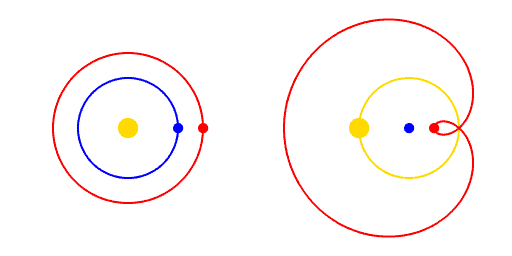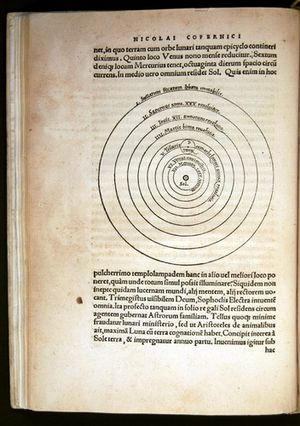Copernican Revolution facts for kids
The Copernican Revolution was a huge change in how people understood the universe. Before this, most people believed that Earth was the center of everything, and the Sun, planets, and stars all revolved around it. This idea was called the Ptolemaic model, named after an ancient astronomer named Ptolemy.
But then, a new idea came along: the heliocentric model. This model said that the Sun was actually at the center of our Solar System, and Earth and the other planets moved around it. This big shift in thinking started with Nicolaus Copernicus and his famous book, De revolutionibus orbium coelestium, published in 1543. The "revolution" continued for over a century, with many scientists like Galileo and Isaac Newton adding to these new ideas.
Contents
Heliocentrism: Sun at the Center
Before Copernicus's Ideas
For a very long time, people believed that Earth was the center of the universe. This idea, called geocentrism, was supported by famous thinkers like Aristotle and Ptolemy. Ptolemy's model was very detailed and explained how the planets seemed to move in the sky, even though it was complicated.
However, some ancient thinkers, like Aristarchus of Samos from ancient Greece, actually thought the Sun might be the center. But their ideas weren't widely accepted.
Over time, astronomers noticed problems with Ptolemy's Earth-centered model. It became very complex to explain why planets sometimes seemed to move backward in the sky (this is called apparent retrograde motion). Scholars in Europe, and even earlier in places like the Maragheh observatory in Persia, started to question these old ideas. They were looking for a simpler and more accurate way to understand how the planets moved.
Nicolaus Copernicus's Big Idea
Nicolaus Copernicus was a Polish astronomer who studied at Bologna University. He carefully studied the movements of the Moon and planets. Around 1514, he wrote a short paper called Commentariolus, where he first shared his idea that the Sun was the center of the universe, not Earth. He shared this paper with only a few friends.
Copernicus spent many years working on his ideas. In 1543, just before he died, he published his major book, De revolutionibus orbium coelestium (which means "On the Revolutions of the Heavenly Spheres"). In this book, he showed detailed diagrams and tables to explain his new model.
His model made some very important claims:
- Earth was not the center of the universe.
- The planets, including Earth, revolved around the Sun.
- Earth spun on its own axis every day, which caused day and night.
Copernicus's work was a huge step, but it wasn't perfect. Other astronomers later improved his ideas. Even though his theories made some people uncomfortable, many scientists realized that his system helped them understand astronomy much better than the old Earth-centered view.
See also
 In Spanish: Revolución de Copérnico para niños
In Spanish: Revolución de Copérnico para niños



